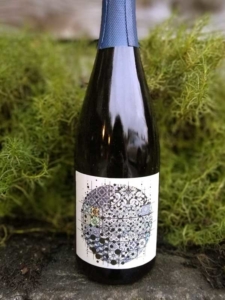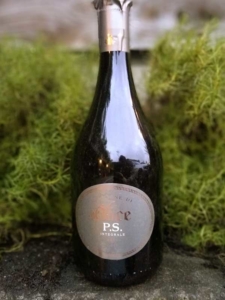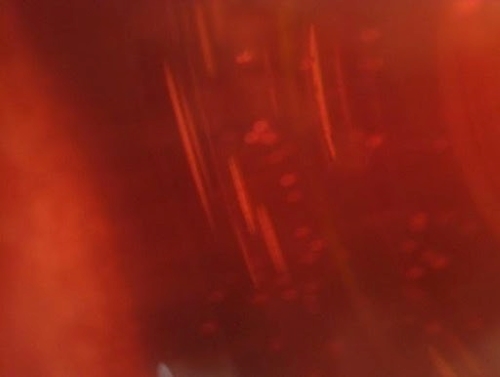Here are two of our core Paul Marcus Wines propositions:
- Sparkling wine is wine.
- Wine is food.
Hence, the inescapable syllogistic conclusion:
Sparkling wine is food.
Yes, sparkling wine is a celebration and a toast and a font of joy and conviviality in this and all other holiday seasons. But it’s also a worthy addition to any meal, a paradise of food-pairing opportunities, and a subject worthy of terroir talk and aesthetic argument. Without further bubbly ado, here are seven of my current favorites available at Paul Marcus Wines.
 Conceito Método Tradicional Grüner Veltliner Brut Nature $28
Conceito Método Tradicional Grüner Veltliner Brut Nature $28
“Método Tradicional” is the Portuguese term for a sparkling wine made in the style of Champagne–in this case, from the unconventional (for Portugal) Austrian grape variety grüner veltliner, planted in the entirely unexpected Douro Valley (which is better known for rich, sweet Ports). “Brut Nature” means no dosage (sugar added to many Champagne-method sparkling wines to balance their acidity), so yes, it’s dry. This is an all-purpose sparkler, but one good pairing is with the crab cakes from our neighbors, Hapuku Fish Shop: The wine’s bone-dry raciness flatters the subtle flavors of crabmeat and highlights the lemony acidity, while a discrete herbal note plays well with the Old Bay seasoning.
 Le Vigne di Alice 2012 Prosecco Brut ‘P.S.’ Metodo Integrale $26
Le Vigne di Alice 2012 Prosecco Brut ‘P.S.’ Metodo Integrale $26
This is grower Prosecco (grown and made by Cinzia Canzian and her family) and is unlike any Prosecco that you’ve had. It sees two fermentations, as Champagne does, with the secondary fermentation in the bottle to create the bubbles. But unlike Champagne, it isn’t disgorged, so the lees (spent yeast cells) remain in the wine. It’s full-on natural: There are no added yeasts, sulfites, dosage, or filtration. The wine has spent almost seven years with the lees, making it more savory and complex. It’s bone dry, umami-rich, and deliberately cloudy because of the lees. (You can clear much of the lees by performing a dégorgement à la volée, as the French call it, but then you’d be losing some of the distinctive, leesy personality.) You want to drink this wine with food, and don’t even think of making a spritz with it! A salumi or cheese antipasto mix would be great, as would stronger fish dishes and game birds. (Full disclosure: I work for the importer of this wine.)
 Beaver Creek Sauvignon Blanc Pét-Nat, Horne Ranch, Lake County $23
Beaver Creek Sauvignon Blanc Pét-Nat, Horne Ranch, Lake County $23
How about a dry-farmed, certified-organic and biodynamic California Pét-Nat (short for Pétillant Naturel, a fizzy wine made with a single fermentation that finishes in the bottle) with no added sulfites? This is true farmer fizz, while still being clean and dry. Many people suggest white Burgundy or other chardonnay with crab, but I did a taste test and found that sauvignon blanc paired better. I’m going to guess that this would be a fun, natty partner to New Year’s cracked crab.
 Forest-Marié Champagne ‘L’Absolu’ Blanc de Blancs Extra Brut $44
Forest-Marié Champagne ‘L’Absolu’ Blanc de Blancs Extra Brut $44
This all-chardonnay sparkler is an exceptional bargain in true grower Champagne (that is, Champagne grown and made by one family). There’s no dosage, so the wine is very dry, and yet not at all severe. It is creamy but focused, dry but not austere, with just a touch of spiciness, all of which creates a happy marriage with many foods, including paté and other charcuterie. I especially enjoy it with the rich, flavorful smoked trout paté from Hapuku.
 André Clouet Champagne ‘No.3’ Grand Cru Brut Rosé $53
André Clouet Champagne ‘No.3’ Grand Cru Brut Rosé $53
This is a pinot noir rosé in bubbly and elegant yet still hedonistic form. It is made from 90 percent pinot noir pressed immediately and made into a white sparkling wine (so-called “blanc de noirs”); 10 percent is pinot noir macerated with the skins and made into a regular, still wine. The Clouet family grows all of the grapes around the aptly named Champagne village of Bouzy. Use this as you would any light-to-medium-bodied still red wine, especially red Burgundy or domestic pinot noir. The earthiness of pinot noir is one of truffles’ best friends, but you can be just as happy with roast chicken, pork, vegetable stews, and a slew of other dishes that benefit from an earthy boost.
 Huré Frères 2009 Champagne ‘Instantanée’ Brut $65
Huré Frères 2009 Champagne ‘Instantanée’ Brut $65
Here’s a chance to find out what aged, vintage Champagne is about without venturing into stratospheric pricing. This is the Huré brothers’ “instantanée,” or photograph, of the 2009 vintage, made from approximate thirds of the three main Champagne grapes (pinot noir, pinot meunier, and chardonnay). It’s aged almost a decade in bottle before disgorgement and has four grams per liter of residual sugar (so, technically, extra brut). It smells like an éclair perched on a rock (brioche, cream, minerals) and tastes like a slowly fermented dream. A wine this good can be a meal in itself, but you could splash it out with lobster or salty-savory caviar. Perhaps just grab some José Andrés potato chips and call it a (very good) day.
 Ulysse Collin Champagne ‘Les Maillons’ Blanc de Noirs Extra Brut $108
Ulysse Collin Champagne ‘Les Maillons’ Blanc de Noirs Extra Brut $108
Olivier (son of Ulysse) Collin is one of the new iconoclasts in Champagne. Since the mid-2000s, he has been growing and making single-parcel, highly vinous wines of great personality. They’re a bit lower in bubbly pressure than most Champagne, which makes them especially apt at the table. Les Maillons is all pinot noir grown in clay-rich soils, with the result being a richer wine that just so happens to have bubbles. I will cop the description from my friend and PMW colleague David Gibson: It’s weightless and yet full on the palate. It’s not distracting with sweetness or acid–simply a full, toasty caress. I’m thinking beef bourguignon; maybe duck or mushrooms.
This is just a small selection of the dozens of sparkling wines in our store this month. Stop in and ask us about some of the others, and help us help you pick out the best bottles of bubbles for your holiday celebration … and beyond.
If you’re looking for a primer on the various types of Champagne producers and styles, you’ll find it here in Mulan Chan-Randel’s articles from our October and November newsletters:
Regional Roundup: A Champagne Appreciation, Part I
Regional Roundup: A Champagne Appreciation, Part II
 Filipa Pato & William Wouters ‘3B’ Extra Bruto Rosé (Portugal – $18)
Filipa Pato & William Wouters ‘3B’ Extra Bruto Rosé (Portugal – $18) Antica Casa Scarpa Spumante Brut Rosé (Italy – $21)
Antica Casa Scarpa Spumante Brut Rosé (Italy – $21) Kobal Blaufränkisch Bajta Pét Nat Rosé (Slovenia – $24)
Kobal Blaufränkisch Bajta Pét Nat Rosé (Slovenia – $24) Bénédicte & Stéphane Tissot Crémant du Jura Extra Brut Rosé (France – $34)
Bénédicte & Stéphane Tissot Crémant du Jura Extra Brut Rosé (France – $34) André Clouet Champagne Brut Rosé No. 3 (France – $53)
André Clouet Champagne Brut Rosé No. 3 (France – $53)

 Conceito Método Tradicional Grüner Veltliner Brut Nature $28
Conceito Método Tradicional Grüner Veltliner Brut Nature $28 Le Vigne di Alice 2012 Prosecco Brut ‘P.S.’ Metodo Integrale $26
Le Vigne di Alice 2012 Prosecco Brut ‘P.S.’ Metodo Integrale $26 Beaver Creek Sauvignon Blanc Pét-Nat, Horne Ranch, Lake County $23
Beaver Creek Sauvignon Blanc Pét-Nat, Horne Ranch, Lake County $23 Forest-Marié Champagne ‘L’Absolu’ Blanc de Blancs Extra Brut $44
Forest-Marié Champagne ‘L’Absolu’ Blanc de Blancs Extra Brut $44 André Clouet Champagne ‘No.3’ Grand Cru Brut Rosé $53
André Clouet Champagne ‘No.3’ Grand Cru Brut Rosé $53 Huré Frères 2009 Champagne ‘Instantanée’ Brut $65
Huré Frères 2009 Champagne ‘Instantanée’ Brut $65 Ulysse Collin Champagne ‘Les Maillons’ Blanc de Noirs Extra Brut $108
Ulysse Collin Champagne ‘Les Maillons’ Blanc de Noirs Extra Brut $108




